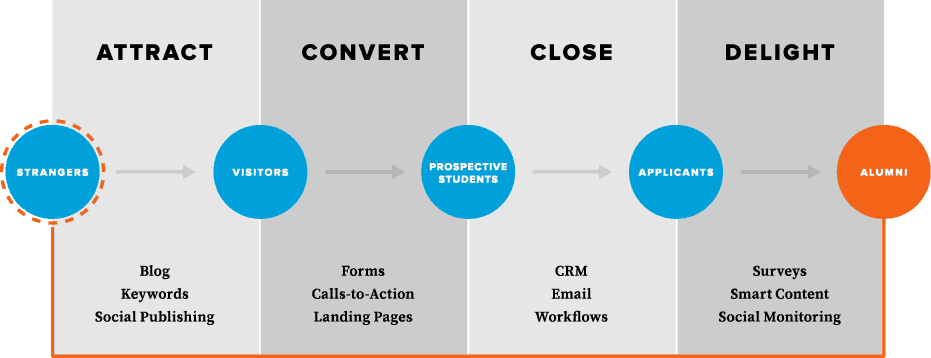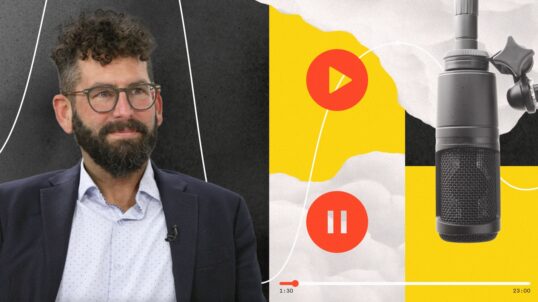Inbound marketing has become the industry standard for modern marketing tactics. While it’s often referenced in terms of B2C and B2B businesses, it’s just as relevant for higher education marketing. If you want to boost enrollment numbers, increase donations, and stay connected with alumni, inbound marketing should be part of your higher ed marketing strategy.
Understanding the Inbound Marketing Cycle

Inbound marketing for higher ed institutions is designed to usher students, donors, and alumni through the entire process of interacting with your university.
First stage of inbound marketing is attracting the right visitors. Whether students are searching for specific education programs or alumni are interested in reconnecting with their college pals, you’ll create content that appeals to those people. The more engaging the content, the more of a result you’ll achieve.
Then you’ll use your content, social media presence, interactive tools, and other inbound strategies to create personalized experiences for your prospects and to drive more engagement and conversions, whether you’re soliciting donations or enrolling new students. Finally, you’ll track specific metrics related to ROI and positive engagements to fine-tune your strategy.
Of course, that summary makes it sound more simplistic than it is. Inbound marketing is actually highly customizable and intricate, especially if you work with an inbound marketing agency that knows how to leverage these strategies effectively. Let’s take a comprehensive look at the inbound marketing process and how it can help your University connect and engage with prospective students, donors and alumni.
Content Marketing: Creating a Foundation for Future Growth
No business can survive without content these days, and higher education institutes aren’t immune to this fact. Students are among the most active online cohort. They use the Internet not only to socialize with their friends and find the nearest coffee shop, but also to research potential schools and to learn what their peers are saying about specific institutions.
According to the Pew Research Center, young adults are the most likely demographic to spend time online. This includes high school students, graduate prospects, and recent grads. Content is a great way to get your institution in front of the younger audience. A mix of useful, engaging, and entertaining content will encourage connections and elevates trust.
For instance, students might log on to social media to learn what other students are saying about your school. If they find links to posts you’ve written that help students make important college decisions, they’ll feel respected and catered to, which can encourage engagement and ultimately enrollment.
How to Use Blogging to Attract Students to Your School – Download our guide and learn how to create and curate blog content for your school, create blog ideas, optimize blog posts to get found by prospective students and how to convert blog traffic into applications.
However, you can’t just type up fluff-filled articles and expect to achieve results. Each article you write needs to be directed toward a specific prospect. This is where user personas — fictional sketches of your target prospect — come in handy. Create a separate user persona for each individual you hope to attract.
For instance, you might have user personas for high school students who are researching schools, undergraduate students who are looking at grad schools, recent alumni, older alumni, and potential donors. You can get as granular as you want with the user personas, creating custom content for each individual.
Creating Personas for University Websites – Download our white paper and find out how to create detailed user personas that will help you determine where to focus your time, guide marketing and allow for alignment across the university.
As you create and publish content, as mentioned above, you’ll gain access to useful data that will help you refine not only your user personas, but also individual pieces of content. Which blog posts appeal the most to your target market? Which social media posts garner the most shares? This information will help you craft targeted content that converts prospects into students and donors.
Further Reading on Content Marketing:
- 4 Content Marketing Don’ts (and What You Should be Doing Instead)
- 75 Content Ideas for Your University or College Blog
- 4 Premium Content Ideas for Higher Ed
Search Engine Optimization: Get Found on the Internet
SEO (search engine optimization) is not only for small businesses and ecommerce websites, it can help your University websites as well.
Think of SEO (search engine optimization) as the mechanics behind your content. The better you optimize your content, the easier it becomes for prospective students and donors to find your University online.
First, it’s important to understand what your audience is searching for. What keywords are they using to find information related to your institution? Once you have gathered a list of search phrases next it’s time to optimize your site content around those keywords. Keywords and phrases must be used sparingly throughout your content so that search engines know what your content is about. Years ago, schools often stuffed their content full of keywords in an attempt to game the search engines, but times have changed. A better strategy is to craft useful and authoritative content around relevant keywords.
Additionally, it’s imperative to optimize the other elements on the page. From images and videos to navigation bars and web forms, optimization should touch every part of your site. Title tags and meta descriptions, alternative text for images, internal links to relevant pages and other page elements can help search engines understand what your content is about.
Content Optimization Best Practices – Discover how optimizing these seven website elements can have a significant impact on the number of people who find your website and learn about your products and services.
Responsive web design is also critical for higher education marketing. You want your website to render beautifully not only on prospects’ laptops and desktops, but also on their mobile devices. Responsive design adjusts itself to fit the screen on which it’s viewed, so your visitors don’t have to worry about unreadable text or frustrating user experiences.
It’s often best to work with digital agencies that know how to optimize every part of a website for the search engines. This is especially true when you already have hundreds or thousands of pages of content. Furthermore, SEO trends and best practices are constantly evolving as Google and other search engines tweak their algorithms to better serve the end user.
Further Reading on SEO:
- A Guide to Optimizing Your University’s Site Content for Search Engines
- 10 key Elements of an Optimized Web Page [Infographic]
Email Marketing: A Personal Connection With Your Prospects
Many higher education marketing efforts fail when it comes to email. In many cases, the lack of response and ROI (return on investment) relates to poor planning, unreasonable expectations, lack of follow-through, and ignorance of permission marketing.
The goal of email marketing should be for your prospective students and donors to engage with your institution. If you’re sending emails without express permission from the recipient or without regard for his or her needs, the chances of engagement and making a potentially profitable connection fade considerably.
Think about all the emails you receive on a weekly basis. How many do you delete unread because you don’t know the sender or recognize the subject matter? You don’t want your University’s emails to suffer the same fate.
The best way to avoid such an eventuality is to get permission (e.g. a student signs up for emails on your website) and to personalize each communication (e.g. adding the recipient’s name to the subject line or body). Both tactics not only increase open rates, but also reassure your prospects that you’re not spamming or interrupting them unnecessarily.
Additionally, each email should have a specific purpose as you nurture leads toward a particular result, such as applying to enroll or making a donation. To that end, you’ll need multiple email marketing strategies to serve each of the user personas described above.
For instance, if a prospective student visits your website to view the curriculum for a specific program, you might offer a web form that promises a free download (such as a guide or video) in exchange for the user’s email address. When the prospect fills out the form, the action triggers the ‘prospective student’ email marketing campaign. He or she receives an email specific to the program or school he or she was interested in.
Using emails to nurture leads through the student, alumni, and donor life cycle can help foster long-term relationships. It’s essential, however, that each email be unique to the prospect’s needs and desires. A prospective student, for instance, probably isn’t interested in a social event for donors.
Similarly, you don’t want to send emails unless you have something relevant to say. Daily emails to announce your latest blog posts will make your prospects tone-deaf to your marketing message. They’ll feel so inundated with communications that they’ll stop paying attention altogether. That’s the last result you want to inspire with your email marketing strategy.
Don’t start an email marketing campaign until you outline the content and a strategy for each campaign. You can always add in fresh content as the campaign progresses, but you’ll want a solid foundation from which to start work.
You can also create an A/B testing program. Use one set of marketing emails for one half of the recipients in a particular user persona group, then target the other half with a different series of emails. Evaluating how each group performs will allow you to fine-tune the language, frequency, and other elements of the campaign.
Social Media Marketing: Meet Your Prospects Where They Are
A presence on Facebook, Twitter, Instagram, Pinterest, and other social media platforms has become increasingly important for higher education institutes. After all, students and alumni spend an inordinate amount of time on social media, whether they’re fostering social connections or reaching out to potential business contacts.
It’s important to have social media as part of your overall inbound marketing strategy. Social media is a great way to get your content in front of your audience. For instance, when you publish a blog post or post an event, you’ll want to post a snippet or teaser on social media to increase awareness and drive traffic from your social media followers.
Regular posting on social media will increase brand awareness for your University and allow you to practice social listening — in other words, paying attention to the conversations that occur online. If you know what donors and students are saying, you can leverage the existing conversations in the context of your University.
Additionally, you can take advantage of social media advertising. Facebook promoted content and Twitter sponsored posts can drastically increase your brand visibility. You’ll get a signal boost that can not only reach hundreds, thousands, or even millions of prospects, but that also specifically targets your user personas.
It takes time to get the hang of social media, but it’s important to actively engage. You can put a team of people in charge of your University’s social media presence so that communications remain consistent and relevant. Continually monitor your social media presence, examining the metrics and analytics to leverage opportunities for growth.
Further Reading on Social Media:
- How to Choose the Right Social Media Channels for Your University
- 6 Hugely Successful Higher Ed Social Media Days of Giving
- 5 YouTube Content Ideas That Will Wow Prospective Students
- 6 Schools That Are Crushing Snapchat
Is Your Higher Education Marketing Strategy Ready for Inbound?
Outbound marketing tactics have become increasingly ineffective. It’s also highly expensive, which means you’ll easily drain your advertising budget without any guarantee of returns.
Inbound marketing is all about creating content specifically designed to appeal to your prospective applicants and donors. In the process you’ll learn more about your user personas and your prospects’ needs, which will allow you to tailor your approach for an even more personalized experience. Furthermore, you’ll gain insight into how students and donors progress through their life cycles.
If you’re not seeing the greatest ROI on your higher ed marketing efforts, we’re here to help. From content creation and SEO to social media and email marketing, we can help your University establish long-term connections with your target market. For more information, contact us to schedule a consultation.



